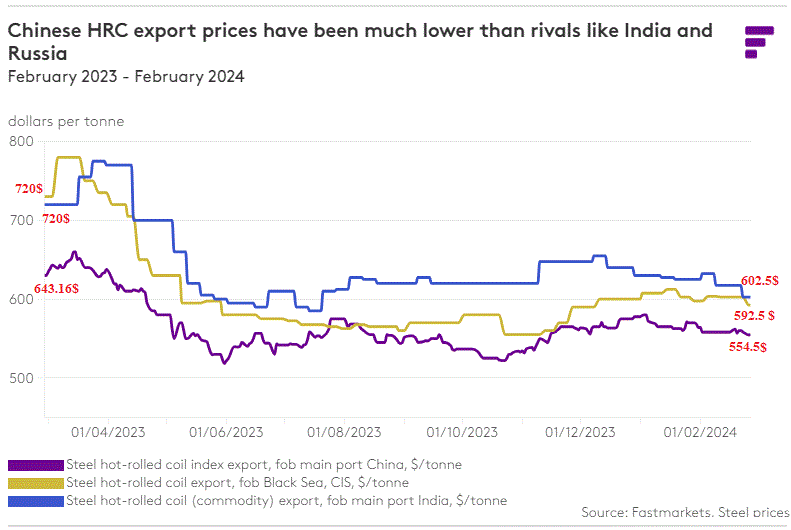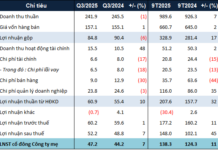
The profitability outlook for China’s steel industry in the 2023 fiscal year is unfavorable amid the real estate sector’s failure to escape the crisis, declining new housing construction, sluggish machinery and equipment sector, investment projects for infrastructure, and other stagnant areas.
The latest report titled “Economic and Commodity Outlook” by BHP, released on February 20, shows that global steel production in the 2023 fiscal year only increased by 0.1% to 1.89 billion tons, which BHP calls “weak continuity” after a 4% decrease in the 2022 fiscal year. In the report, the world’s leading mining company stated that the global steel production rate in the 2023 fiscal year, which ends in June 2023, is aligned with the steel industry’s performance in developed regions, not emerging markets dominated by China and India.
“(Mainland China and India), as predicted, are two common ‘stable sources’ for global commodity demand in the 2023 calendar year (from January to December) with steel production value chains taking center stage, but the disconnection from developing countries arises from different reasons, which could be statistical methods,” BHP said.
BHP said that an alternative statistical method for China’s steel production, based on physical indices of raw material consumption and survey data on capacity utilization, is expected to add about 30 million tons to official figures, pushing up the global steel growth rate to around 1.5%.
Below are the 7 main reasons why BHP is uncertain about the global steel market prospects in 2024:
1. High production and export of steel in China and India in 2023
China recorded its 5th consecutive year of crude steel production exceeding 1 billion tons thanks to solid demand from non-residential sectors.
The country’s steel industry also saw a significant increase in net exports, with total trade reaching its highest level in 7 years in the 2023 fiscal year. Export volume increased to 98 million tons in 2023, the highest since 2016.
India’s steel industry also had a strong year in 2023 with crude steel production reaching 140 million tons, up 12% over 2022 and 40% since 2020.
The Indian market is considered the only bright spot in the Asian steel market in 2023 amid weak demand and continuous oversupply in the region, with domestic demand still strong despite headwinds globally and rising interest rates.
2. Strong blast furnace utilization rate in China
China’s blast furnace utilization rate (BF) averaged 88% in the first half of 2023 and 90% in the second half, reaching 89.1% for the entire year, compared with 84% in the 2022 fiscal year.
BHP stated that BF can run at high capacity due to: (1) limited operations of electric arc furnace (EAF) steelmaking due to competitive disadvantages, weak demand for construction steel, reduced availability of scrap, and loss of profit; (2) abundant steel supply in the global export market; and (3) relatively stable flat steel sector in 2023, with demand increasing by 2% compared to 2022, particularly a 3.2% growth in the second half of 2023 compared to the same period last year.
3. Low actual profits of Chinese steel producers
The actual profit margin of Chinese steel producers throughout the 2023 fiscal year is very low. BHP estimates that the average profit margin of blast furnace-basic oxygen furnace (BF-BOF) facilities was around $7 per metric tonne in the calendar year 2022, but dropped to a negative $6 per metric tonne in the 2023 fiscal year.
4. Forecast of stable steel production in China in 2024
BHP’s preliminary estimate for China’s crude steel production in 2024 ranges from 1 to 1.1 billion tonnes, extending the stable streak of 5 consecutive years (2019-2023) to 6.
BHP noted that official statistics could even indicate unchanged results compared to the announced 1.019 billion tonnes for 2023.
BHP also noted that production could be affected by potential mandatory production cuts in China, but added: “the annual scale, timing, and severity of any potential reductions remain uncertain”. Overall, BHP is not yet certain about the prospects of China’s crude steel production in the 2024 fiscal year.
5. China’s steel exports in 2024 will decrease
BHP predicts that China’s net steel exports in 2024 will decrease compared to 2023, to over 87 million tonnes, due to Beijing’s efforts to restrict steel production. However, the decrease will not be significant and is unlikely to fall below the 54 million tonnes in 2022 due to China’s steel price advantage compared to other origins in the international market.

Fastmarkets’ calculations on the daily HRC export steel price index FOB main ports in China (averaging $574.51 per metric tonne in 2023)
6. Uneven demand from end users in China in 2024
BHP is cautiously assessing the demand prospects of end users for steel in China in 2024, including the pace, scale, and structure of the housing construction recovery process, as well as the ratio of steel usage to GDP. At present, BHP is still uncertain about China’s economic prospects in the 2024 fiscal year and expects that the actual GDP will increase from 4.5% to 5%, following a growth rate of 5.2% in 2023, and will continue to show noticeable weakness in housing construction, infrastructure, machinery and equipment manufacturing, while the prospects for the automotive, shipbuilding, and consumer goods sectors are uncertain.
7. China will increase steel stockpiles by the mid-21st century
In the long run, BHP believes that China will increase its accumulated steel inventory (currently about 9 tonnes per capita) by 1.5 to 1.75 times when the urbanization rate reaches around 80%. The company also expects China to achieve a similar standard of living as current high-income countries by the mid-21st century.
“China’s current inventory is still much lower than that of the United States, which is about 12 tonnes per capita. Germany, South Korea, and Japan have similarities to China in terms of development strategies, industry structure, economic geography, and demographics and even have higher inventories than the United States,” BHP said.
Source: Fastmarkets





































